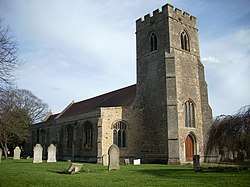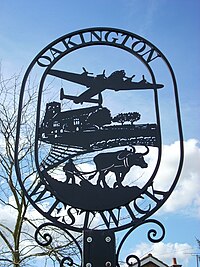Oakington
| Oakington | |
| Cambridgeshire | |
|---|---|

| |
| Location | |
| Grid reference: | TL412645 |
| Location: | 52°15’41"N, 0°4’7"E |
| Data | |
| Population: | 1,297 (2001) |
| Post town: | Cambridge |
| Postcode: | CB24 |
| Dialling code: | 01223 |
| Local Government | |
| Council: | South Cambridgeshire |
| Parliamentary constituency: |
South Cambridgeshire |
Oakington is a small village in Cambridgeshire, 4 miles north-west of Cambridge.
Listed as Hochinton in the Domesday Book of 1086, the name "Oakington" means "Hocca's estate" after an otherwise unknown founder.[1]
Church
The parish church of St Andrew comprises a chancel, aisled nave with rebuilt south porch, and west tower. Parts of the nave date back to the 12th century, and the church was substantially rebuilt in the 13th century.
- Church of England: Sr Andrew
- Baptist
- Methodist
Oakington Barracks
Half a mile north of the village, Oakington Barracks lies empty. Created as RAF Oakington in 1939, the air base closed eventually in the 1970s and was handed over to the army as a barracks. This closed at the end of the century. The Oakington Immigration Reception centre operated from the site for ten years from 2000, and though in 2007 plans were published to build a new "eco-town" on the site, this has not been progressed.
History
Oakington formed just over a mile to the northeast of the ancient route between Cambridge and Huntingdon followed by the Roman Via Devana and now the A14. Early Anglo-Saxon burials have been found near the church. The ancient parish of Oakington covered 1,692 acre, bounded in the south by the road. The Beck Brook separated it from Westwick and Histon to the east, and field boundaries divided it from Longstanton to the north, and Girton to the south.[2]
The village has long been paired with neighbouring Westwick, and the latter has relied on Oakington for a parish church since the 13th century. The two villages have formed a single civil parish ('Oakington and Westwick') since 1985.
After reaching a peak population of 610 in 1851, poverty led to widespread emigration to Adelaide, Australia, and it was reported that the population fell by a third in three years. New housing was built after the Second World War and the population has risen steadily since.[2]
The railway reached the parish in 1847, with the Oakington railway station opening in 1848. The line closed in 1970, but is now used by the Cambridge to St Ives guided bus.
In 1909 two Oakington residents, Messrs Grose and Feary, built a monoplane in an attempt to win the Daily Mail prize for £1,000 for the first Briton to fly a circular mile in an all-British aeroplane.[3]
From 1940 a Royal Air Force bomber airfield, RAF Oakington, was constructed at Oakington covering 540 acres and served as a station for Short Stirling bomber forces and reconnaissance planes. In the post war period it was used for flight training, in the last period with Vickers Varsity aircraft; however when the need for training on piston-engined planes reduced, it was converted to a barracks in 1975, which in turn closed in 1999. The site was then leased to the Home Office and was converted into Oakington Immigration Reception Centre, an immigration detention centre. The airfield contracted after the war and much evidence of its former presence is visible in farmland surrounding the current perimeter.[2][4]
About the village
Oakington now has but one pub, The White Horse at Alehouse Green, which is recorded from the 1760s and was rebuilt after a fire in 1805. The New Inn opened near the former station in 1858 and closed after 1980.[2]
In 2007, the Government announced a plan to build a new "eco-town" on the sight of the barracks and attached airfield, to be called "Northstowe". It was later abandoned in more financially realistic times.
At the village crossroads, the east-west road from Histon to Longstanton crosses the north-south road from Cottenham to Dry Drayton. Between Oakington and the nearby hamlet of Westwick runs the former railway branch line, with the former station that is now part of the Cambridge to St Ives guided bus track. Next to the track, the 150-year-old bridge over Beck Brook was completely rebuilt in 2006.
Outside links
| ("Wikimedia Commons" has material about Oakington) |
References
- Hamlin, John F. Oakington (Airfield Focus No. 10). Bretton, Peterborough, UK: GMS Enterprises, 1991. ISBN 1-870384-23-7
